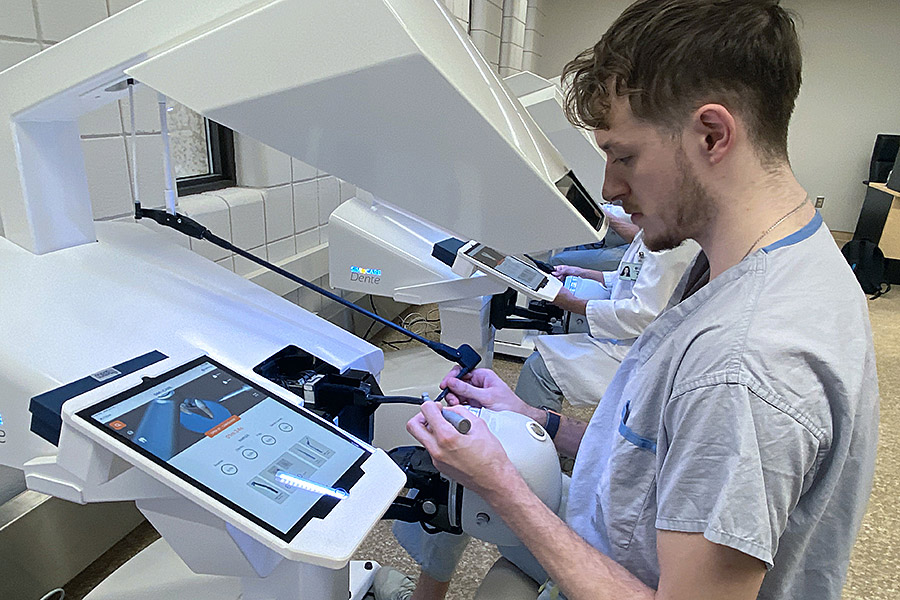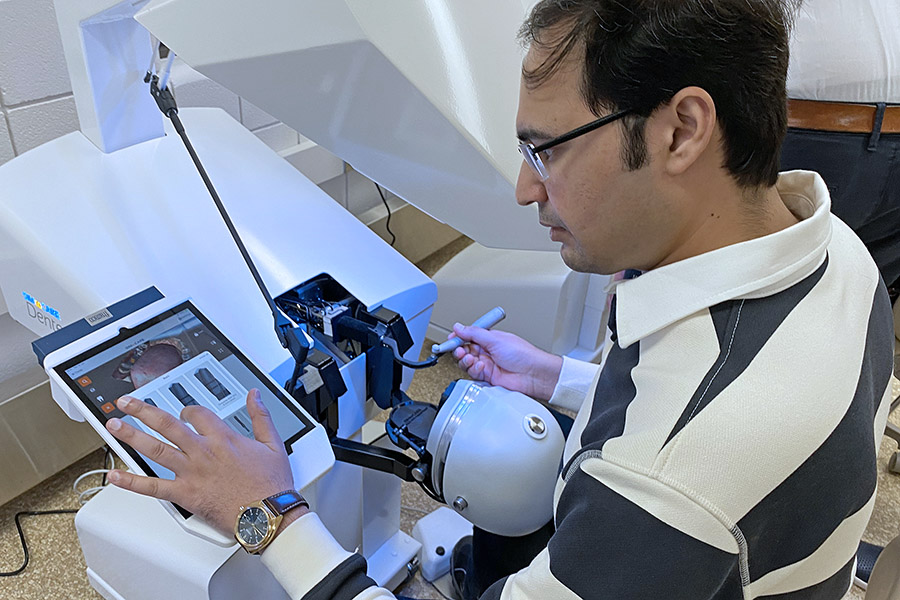
New reality for dental training at USask
Augmented reality simulators provide Dentistry students with an experience that replicates patient treatment.
By Rod DrabbleThere’s a new reality for students training to become dentists, dental assistants and dental therapists.
Augmented reality simulators installed at the University of Saskatchewan College of Dentistry give students the opportunity to better develop and refine their skills as they drill, fill or clean the teeth of virtual patients.
Dr. Gerry Uswak (DMD, MPH), an associate professor at the college and registrar of the College of Dental Surgeons of Saskatchewan, expects the simulators to provide significant benefits as part of preclinical training
“This is on the front end of changing of how we train dentists for the future,” Uswak said. “This is massive in terms of the impact on dental education and how that will make for better graduates. We want the beginning practitioner to be competent, and this will aid in the development of that competency.”
The college is the first Canadian dental school to acquire the cutting-edge technology. Ten simulators have been purchased to provide students with a unique, hands-on learning experience in the college's Mixed Reality Patient Simulation Learning Space.
Dr. Walter Siqueira (DDS, PhD), dean of the College of Dentistry, said the simulators illustrate the college’s commitment to providing dental training that is among the best in Canada.
“The college is doing important work in educating and training the next generations of oral health providers,” Siqueira said. “These simulators will expand the student experience. We are opening the door to new learning opportunities in our preclinical labs to better prepare students for their transition into direct patient care, first in the college’s Dental Education Clinic and later in professional practice.
“This is a great story for the College of Dentistry, the university and our province. As the first Canadian school to acquire these simulators, and one of just a few in North America, we are on the leading edge and will be contributing to the evolution of this technology. This is another opportunity to demonstrate the valuable role played by our college.”
 The simulator combines reality — an adjustable phantom head along with a high-tech handpiece and dental mirror — with virtual reality objects. When using the simulator, students are positioned as they would be in a dental clinic, looking down on their patient. A full virtual representation of the teeth, mouth and tongue is viewed through the simulator’s eyepiece. A few taps on an adjacent control screen lets users choose from a selection of virtual tools that can be applied to the handpiece.
The simulator combines reality — an adjustable phantom head along with a high-tech handpiece and dental mirror — with virtual reality objects. When using the simulator, students are positioned as they would be in a dental clinic, looking down on their patient. A full virtual representation of the teeth, mouth and tongue is viewed through the simulator’s eyepiece. A few taps on an adjacent control screen lets users choose from a selection of virtual tools that can be applied to the handpiece.
Once a tool is activated and touched to the surface of the virtual tooth, students can hear the whir and sense the vibration in their fingers. They feel the tool move across the tooth; they can track the progress of the work through the eyepiece and can even see small showers of virtual debris coming from the area of the work.
Providing an accurate depiction of the forces and feel involved in dental procedures contributes to an immersive learning experience. Users say the integration of high-level haptic (touch) technology into an augmented reality interface provides an experience that is close to an in-person patient procedure.
The way in which haptic technology is being applied to dental simulation is drawn directly from the aviation world. Engineers for SIMtoCARE, the company that developed the simulators, once worked on flight simulators for Fokker, a Dutch aviation firm.
“What makes our machines quite unique is that they have a very high realism in their haptic feedback,” said Tom de Jong Boers, technical project manager for SIMtoCARE. “It is all derived from the very high accuracy of feedback forces that we have learned to use in the flight simulators.”
Uswak said mixed reality simulators are a significant advance from existing simulation methods. Currently, dental manikins with acrylic teeth are used primarily by first and second-year students to learn treatment skills in a preclinic setting. That prepares students to perform procedures on actual patients.
“This simulator creates a virtual environment that reflects reality better than anything else,” Uswak said. “It gives you the immediate haptic feedback. The controls and views are very intuitive. It is very learnable, it is very translatable, and it is the best representation of the feel of an actual tooth in the mouth.”
 Procedures available for simulation include manual dexterity exercises, operative dentistry, prosthodontics, access cavity to root canals and implantology. The ability to import an intraoral scan from a patient into the simulator offers students the opportunity to create a simulation and practice a challenging treatment before the patient is in the chair.
Procedures available for simulation include manual dexterity exercises, operative dentistry, prosthodontics, access cavity to root canals and implantology. The ability to import an intraoral scan from a patient into the simulator offers students the opportunity to create a simulation and practice a challenging treatment before the patient is in the chair.
In addition to the benefits of high-tech, hands-on learning for students, the simulators will capture data that can be used to assess procedures and track skill development for individuals and across a class or grouping. That will benefit the educational component of dentistry training and better support evaluation during preclinic settings.
“We capture all of this information,” Siqueira said. “For example, you can link to a good filling preparation and then look at the data. How long did it take? How long was the drilling? Then you get the richness of the data of an entire class … and you can look at the data to determine student performance and areas needed for improvement.”
Article re-posted on .
View original article.

